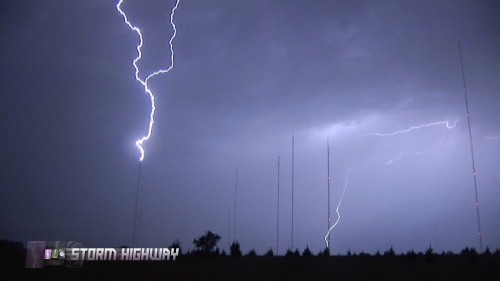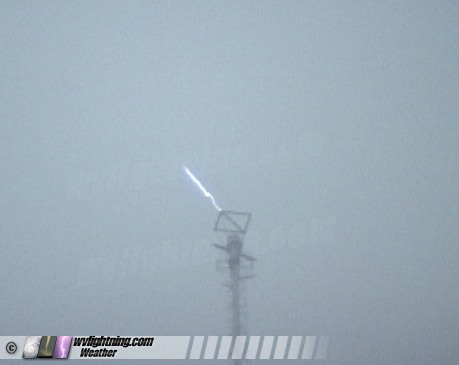
Tower lightning in Oklahoma City: 'Incomplete leader' phenomenon observed
May 7, 2007
ABOVE: Upward-moving lightning at the Oklahoma City 'tower farm'.
EXPEDITION VIDEO: Oklahoma City tower lightning: Watch Video
Click any thumbnail on this page to view a larger version.
OKLAHOMA CITY, OK - If I know in advance that Oklahoma City will have a chance of storms and I happen to be within a few hour's drive, I will make every effort to be there. The famous 'tower farm', a cluster of tall television and radio towers north of the city, is well-known for its displays of upward moving lightning during thunderstorms.
On the night of May 6, convection was firing all around OKC, and I knew it was only a matter of time before something moved over the towers. I stayed in OCK at the towers from 10PM until 8AM the next morning as continuous storms moved overhead. Despite the constant lightning, I only observed and caught two tower strikes. I was plagued by periodic low clouds obscuring the towers, as well as east winds ruining my preferred vantage point southwest of the tower farm. I had to move to the northeast side to keep wind-driven rain off of the lenses. Nonetheless, it was quite a show with lots of anvil crawlers and cloud-to-ground lightning all night.
Around 4AM, the only two tower discharges I observed happened within 2 minutes of each other. Unlike most events here where multiple towers get hit simultaneously, these two were single-tower discharges. The same tower, one on the eastern side of the cluster, was hit both times.
 
In one instance, the upward propagation of the discharge was visible in a single video frame:

Large 'anvil crawler' discharges filled the skies for most of the night.
 
I observed, for the second time in my career, the phenomenon where an anvil crawler discharge over the towers initiated lightning leaders from at least two of the towers. These leaders did not propagate all the way into the cloud to complete a full discharge, but rather ended abruptly in mid-air about 100 feet or so above the tower tips. While the leaders were not visible to the naked eye nor on video due to the relative brightness of the simultaneous anvil crawler overhead, the thunder from the leaders was very distinct. You can clearly hear the thunder from the leaders at the beginning of the video clip. After the anvil crawler, you can hear the short 'crackles' from the leaders, followed by a brief silence, then finally the louder thunder from the anvil crawler itself.
These leaders are the 'start' of upward lightning discharges that did not make it to full connection in the cloud. Anvil crawlers seem to be the main triggers for tower lightning, as they 'pull' leaders off of the towers below. Some leaders make it, others don't.
I was shooting 35mm slides of this event, and the leaders may show up on the slide after I get them developed.
While the video cameras were 'blinded' by the main anvil crawler and therefore did not catch these leaders, I have been able to capture this phenomenon before at the WVAH tower in West Virginia. Here is a shot of a 'non-connecting' or 'incomplete' leader that did not continue to full discharge into the cloud, the same type of event that occured at the Oklahoma towers:

'Incomplete leader' at the WVAH TV tower, WV
NEXT EVENT: Lightning in Illinois >
GO: Home | Storm Chase Logs | Photography | Extreme Weather Library | Stock Footage | Blog
Featured Weather Library Article:
|